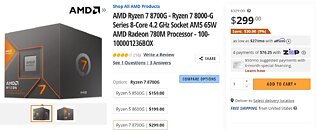- Joined
- Oct 9, 2007
- Messages
- 47,670 (7.43/day)
- Location
- Dublin, Ireland
| System Name | RBMK-1000 |
|---|---|
| Processor | AMD Ryzen 7 5700G |
| Motherboard | Gigabyte B550 AORUS Elite V2 |
| Cooling | DeepCool Gammax L240 V2 |
| Memory | 2x 16GB DDR4-3200 |
| Video Card(s) | Galax RTX 4070 Ti EX |
| Storage | Samsung 990 1TB |
| Display(s) | BenQ 1440p 60 Hz 27-inch |
| Case | Corsair Carbide 100R |
| Audio Device(s) | ASUS SupremeFX S1220A |
| Power Supply | Cooler Master MWE Gold 650W |
| Mouse | ASUS ROG Strix Impact |
| Keyboard | Gamdias Hermes E2 |
| Software | Windows 11 Pro |
Prices of AMD Ryzen 8000G "Hawk Point" desktop APUs in the Socket AM5 package saw reductions over the week. The Ryzen 7 8700G, the fully unlocked part, is now available for $299, a $30 cut from its launch price of $329. Meanwhile, the Ryzen 5 8600G has now slipped under the $200-mark, with a $199 price-tag. The chip had originally launched at $229. Both these chips feature a 16 TOPS NPU, and are the first desktop processors that are capable of on-chip AI acceleration. Both processors are based on the 4 nm "Hawk Point" monolithic silicon, and feature "Zen 4" CPU cores. The 8700G packs an 8-core/16-thread CPU with an RDNA 3 iGPU that has 12 compute units (CU); while the 8600G is 6-core/12-thread, with an iGPU that has 8 CU.
Things get interesting with the Ryzen 5 8500G, which is now down to $159 from its launch price of $179. This new price makes the processor competitive with the 13th Gen Core i3 and the lower end of the Core i5 lineup. Unlike the other two 8000G series chips, the 8500G lacks an NPU, and is based on the 4 nm "Phoenix 2" silicon that has two "Zen 4" and four "Zen 4c" CPU cores for a 6-core/12-thread CPU configuration. Both kinds of cores share a 16 MB L3 cache. It has a heavily cut-down RDNA 3 iGPU with just 4 CU. The Ryzen 8000G desktop APU series only features PCIe Gen 4 (no Gen 5), which may not mean much for today's discrete GPUs, but limit your SSD upgrade path to Gen 4 (Gen 5 SSDs will be limited to 7 GB/s).

View at TechPowerUp Main Site | Source
Things get interesting with the Ryzen 5 8500G, which is now down to $159 from its launch price of $179. This new price makes the processor competitive with the 13th Gen Core i3 and the lower end of the Core i5 lineup. Unlike the other two 8000G series chips, the 8500G lacks an NPU, and is based on the 4 nm "Phoenix 2" silicon that has two "Zen 4" and four "Zen 4c" CPU cores for a 6-core/12-thread CPU configuration. Both kinds of cores share a 16 MB L3 cache. It has a heavily cut-down RDNA 3 iGPU with just 4 CU. The Ryzen 8000G desktop APU series only features PCIe Gen 4 (no Gen 5), which may not mean much for today's discrete GPUs, but limit your SSD upgrade path to Gen 4 (Gen 5 SSDs will be limited to 7 GB/s).

View at TechPowerUp Main Site | Source







